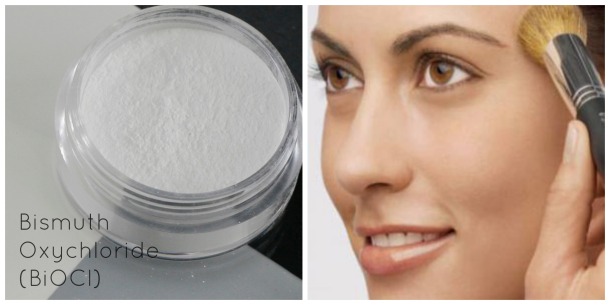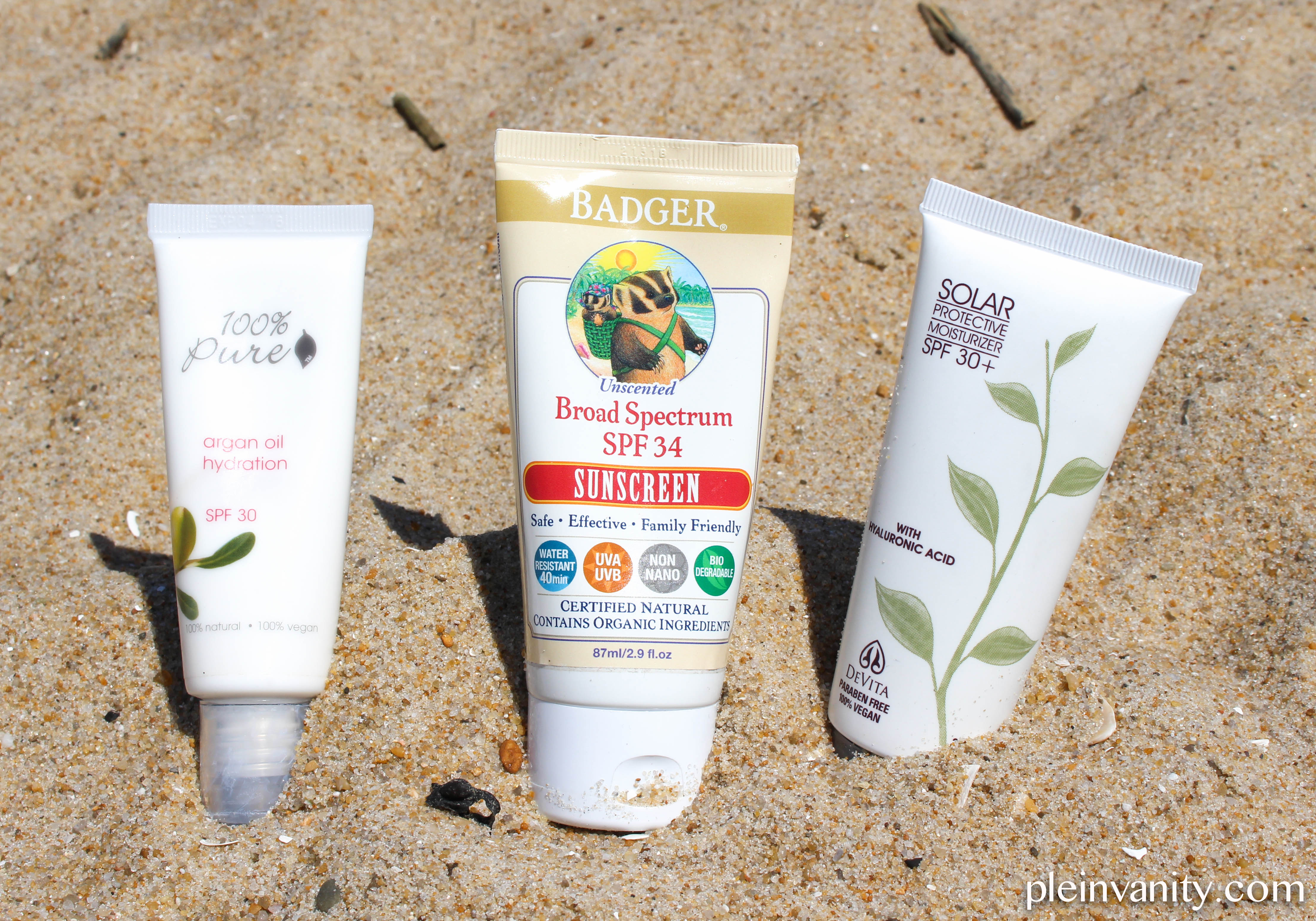I’ve seen this ingredient listed in a few natural products before and I’ve always been curious due to its complex name, what exactly is bismuth oxychloride?
Used in cosmetics since the time of the ancient Egyptians, bismuth oxychloride is a pearly, white pigment used to give products a lustrous, iridescent sheen and also used because of its fine, powdery texture that adheres well to skin. You can find bismuth oxychloride in many mineral-based makeup products today like face powders, eye shadows and even in nail polish.
“Bismuth oxychloride was permanently listed by the FDA as a coloring agent in 1977 and as a synthetic ingredient.” -Paula’s Choice
Bismuth oxychloride is an inorganic compound of bismuth, which is found naturally in the rare mineral, bismoclite. While bismuth occurs naturally in bismoclite, the rare number of these minerals presents a production challenge. “To create the high amounts of bismuth needed by U.S. manufacturers, bismuth is also produced as a by-product from refining lead, tin, copper, silver, and gold ores. Once separated from these elements, it has to go through a long process of refining to make it safe for use in cosmetics.” (Source: Annmarie Gianni Skincare)
To get a little more technical, bismuth oxychloride is created by combining bismuth, which is also a by-product of lead and copper metal refining, with chloride (chlorine compound) and water.
There are many claims that bismuth oxychloride is a more natural, pure and healthier alternative to using talc, however, bismuth oxychloride seldom occurs in nature due to it’s inorganic origins. Bismuth oxychloride is also heavier and more brittle than talc.
Some concerns for using bismuth oxychloride in cosmetics and personal care products are largely that it is a skin irritant. Many people, especially those with sensitive skin, react to bismuth oxychloride due to its crystalline chemical structure which can poke at skin and get stuck in pores. Itching, rashes, blackheads, whiteheads, postules and even cystic acne may result.
“This ingredient requires a lot of refining to get rid of traces of lead. In the U.S., cosmetics have to meet certain standards for bismuth [oxy]chloride, but in other countries, those regulations may not be as strict, which increases the risk of bismuth oxychloride that may be contaminated with potentially toxic ingredients.” -Annmarie Gianni Skincare
The EWG’s Skin Deep database lists bismuth oxychloride with a score of 0 for overall health concerns and also due to limited data available. Though bismuth oxychloride may not be as terrible an ingredient as others, (there is no speculation it causes cancer or other serious health concerns) it is good to be aware of where your ingredients come from and the possible risks it can have on your skin. I personally have quite sensitive and reactive skin so I would stay away from any products that may have bismuth oxychloride in them. I also do not feel comfortable with this ingredient due to the possibilities of its inorganic sourcing.
Do you currently use or have you used any products with bismuth oxychloride? Do you have a favorite product or company with bismuth oxychloride-free products?
Popular mineral-based makeup products that contain bismuth oxychloride:
–BareMinerals Original Foundation Broad Spectrum SPF 15
–Anastasia Beverly Hills Tinted Brow Gel
–Too Faced Boudoir Eyes Eyeshadow Palette
–Obsessive Compulsive Cosmetics Nail Lacquer
–Hourglass Cosmetics Ambient Lighting Powder
Mineral makeup companies with bismuth oxychloride-free products:
Follow me on Twitter, Facebook and Bloglovin!

Resources: Afterglow Cosmetics, Annmarie Gianni Skincare, Environmental Working Group, Paula’s Choice, Wikipedia Photo sources: Impact Colors Inc, Sterling Minerals, Webmineral






callitvanity
I too have wondered about this ingredient before and have chosen to stay away from it. Like you said, it’s not worth the risk if you have sensitive and reactive skin and there are plenty of great brands who don’t use it 🙂
Mayah x
Kasey Michelle
Hi Mayah, yes I agree! I know with my skin, it’s better to be safe than sorry. I’m always curious about ingredients I don’t recognize and feel compelled to do research and to share! Hope this helped 🙂
Mademoiselle nature (@MlleNature)
Really nice post! x
Kasey Michelle
Thank you and thanks for reading! 🙂
beauty
the traces of lead in this ingredient could be dangerous for skin so we must take care while using these products..
Acorn Alley
Inorganic lead is not absorbed through the skin, and therefore is not dangerous for skin. However, lead in powder can be inhaled or it can fall onto the lips and be ingested, both of which are hazardous.
Kasey Michelle
Thanks for both of your comments. Acorn Alley, according to the research I have done, you are correct it seems inorganic lead is not absorbed through the skin. According to the U.S. OHSA: “Lead can be absorbed into your body by inhalation (breathing) and ingestion (eating). Lead (except for certain organic lead compounds not covered by the standard, such as tetraethyl lead) is not absorbed through your skin”.
However, I think that as it is difficult to measure how much lead is being absorbed on our skin and in our bodies daily from products we use, it is best to prevent harmful levels of any type of lead as much as possible. This means being aware of the ingredients in products, the frequency at which you’re using certain things on your body and choosing healthier alternatives. The OHSA states: “When absorbed into your body in certain doses lead is a toxic substance. The object of the lead standard is to prevent absorption of harmful quantities of lead. The standard is intended to protect you not only from the immediate toxic effects of lead, but also from the serious toxic effects that may not become apparent until years of exposure have passed.” Awareness and prevention is key in protecting your health and your body.
Hope this helps. Thanks again for your comments!
Acorn Alley
Kasey Michelle,
Hence my comment “However, lead in powder can be inhaled or it can fall onto the lips and be ingested, both of which are hazardous.” I was responding to Beauty, who implied that lead was somehow bad for skin; it is not, but rather it should not be ingested or inhaled.
Kasey Michelle
Yes, thanks. Meant the reply to be for Beauty as well!
Rachel
What a great and balanced look at this ingredient. I have used bareMinerals foundation nearly daily since October and haven’t got any immediate problems to report (it actually seems to have improved my skin somehow?!) but I am going to be cautious when I purchase my next foundation and will go with one without Bismuth Oxychloroide. Thanks for providing some great info!
Rach xx
AllNaturalAspirations.com
Kasey Michelle
Hi Rachel, I’m glad you’ve found my post helpful! 🙂 Thanks for reading!
-Kasey
Hana (@hanakhay)
Thank you for your research, amazing, I have read about this topic but probably not enough thouroughfully, will not buy products with it again. I do not have sensitive skin but I care about as gentle, simple and sustainable as possible because of the environment so we do definitely not need another hard to obtain ingredient. Take care, Kasey
Kasey Michelle
Hi Hana,
Thanks for your comment! I’m glad to have helped you better understand this ingredient. I think there is nothing better than to be a knowledgeable and informed consumer! 🙂 Thanks for reading!
-Kasey